List of gravitationally rounded objects of the Solar System
This is a list of most likely gravitationally rounded objects of the Solar System, which are objects that have a rounded, ellipsoidal shape due to their own gravity (but are not necessarily in hydrostatic equilibrium). Apart from the Sun itself, these objects qualify as planets according to common geophysical definitions of that term. The sizes of these objects range over three orders of magnitude in radius, from planetary-mass objects like dwarf planets and some moons to the planets and the Sun. This list does not include small Solar System bodies, but it does include a sample of possible planetary-mass objects whose shapes have yet to be determined. The Sun's orbital characteristics are listed in relation to the Galactic Center, while all other objects are listed in order of their distance from the Sun.
 |
| Objects |
|---|
|
| Lists |
|
| Planets |
|
|
Star
The Sun is a G-type main-sequence star. It contains almost 99.9% of all the mass in the Solar System.[1]
| Sun[2][3] | ||
|---|---|---|
 | ||
| Symbol (image)[q] | ||
| Symbol (Unicode)[q] | ☉ | |
| Discovery year | Prehistoric | |
| Mean distance from the Galactic Center |
km light years |
~2.5×1017 ~26,000 |
| Mean radius | km :E[f] |
695,508 109.3 |
| Surface area | km2 :E[f] |
6.0877×1012 11,990 |
| Volume | km3 :E[f] |
1.4122×1018 1,300,000 |
| Mass | kg :E[f] |
1.9855×1030 332,978.9 |
| Gravitational parameter | m3/s2 | 1.327×1020 |
| Density | g/cm3 | 1.409 |
| Equatorial gravity | m/s2 g |
274.0 27.94 |
| Escape velocity | km/s | 617.7 |
| Rotation period | days[g] | 25.38 |
| Orbital period about Galactic Center[4] | million years | 225–250 |
| Mean orbital speed[4] | km/s | ~220 |
| Axial tilt[i] to the ecliptic | deg. | 7.25 |
| Axial tilt[i] to the galactic plane | deg. | 67.23 |
| Mean surface temperature | K | 5,778 |
| Mean coronal temperature[5] | K | 1–2×106 |
| Photospheric composition | H, He, O, C, Fe, S | |
Major planets
| Key | ||
|---|---|---|
| * Terrestrial planet |
° Gas giant |
× Ice giant |
In 2006, the International Astronomical Union (IAU) defined a planet as a body in orbit around the Sun that was large enough to have achieved hydrostatic equilibrium and to have "cleared the neighbourhood around its orbit".[6] The practical meaning of "cleared the neighborhood" is that a planet is comparatively massive enough for its gravitation to control the orbits of all objects in its vicinity. In practice, the term "hydrostatic equilibrium" is interpreted loosely. Mercury is round but not actually in hydrostatic equilibrium, but it is universally regarded as a planet nonetheless.[7]
According to the IAU's explicit count, there are eight planets in the Solar System; four terrestrial planets (Mercury, Venus, Earth, and Mars) and four giant planets, which can be divided further into two gas giants (Jupiter and Saturn) and two ice giants (Uranus and Neptune). When excluding the Sun, the four giant planets account for more than 99% of the mass of the Solar System.
| *Mercury[8][9][10] | *Venus[11][12][10] | *Earth[13][14][10] | *Mars[15][16][10] | °Jupiter[17][18][10] | °Saturn[19][20][10] | ×Uranus[21][22] | ×Neptune[23][24][10] | ||
|---|---|---|---|---|---|---|---|---|---|
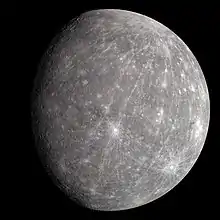 |
 |
 |
 |
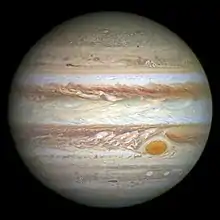 |
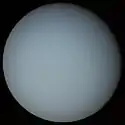 |
_flatten_crop.jpg.webp) | |||
| Symbol[q] | |||||||||
| Symbol (Unicode)[q] | ☿ | ♀ | 🜨 | ♂ | ♃ | ♄ | ⛢ or ♅ | ♆ | |
| Discovery year | Prehistoric | Prehistoric | Prehistoric | Prehistoric | Prehistoric | Prehistoric | 1781 | 1846 | |
| Mean distance from the Sun |
km AU |
57,909,175 0.38709893 |
108,208,930 0.72333199 |
149,597,890 1.00000011 |
227,936,640 1.52366231 |
778,412,010 5.20336301 |
1,426,725,400 9.53707032 |
2,870,972,200 19.19126393 |
4,498,252,900 30.06896348 |
| Equatorial radius | km :E[f] |
2,440.53 0.3826 |
6,051.8 0.9488 |
6,378.1366 1 |
3,396.19 0.53247 |
71,492 11.209 |
60,268 9.449 |
25,559 4.007 |
24,764 3.883 |
| Surface area | km2 :E[f] |
75,000,000 0.1471 |
460,000,000 0.9020 |
510,000,000 1 |
140,000,000 0.2745 |
64,000,000,000 125.5 |
44,000,000,000 86.27 |
8,100,000,000 15.88 |
7,700,000,000 15.10 |
| Volume | km3 :E[f] |
6.083×1010 0.056 |
9.28×1011 0.857 |
1.083×1012 1 |
1.6318×1011 0.151 |
1.431×1015 1,321.3 |
8.27×1014 763.62 |
6.834×1013 63.102 |
6.254×1013 57.747 |
| Mass | kg :E[f] |
3.302×1023 0.055 |
4.8690×1024 0.815 |
5.972×1024 1 |
6.4191×1023 0.107 |
1.8987×1027 318 |
5.6851×1026 95 |
8.6849×1025 14.5 |
1.0244×1026 17 |
| Gravitational parameter | m3/s2 | 2.203×1013 | 3.249×1014 | 3.986×1014 | 4.283×1013 | 1.267×1017 | 3.793×1016 | 5.794×1015 | 6.837×1015 |
| Density | g/cm3 | 5.43 | 5.24 | 5.52 | 3.940 | 1.33 | 0.70 | 1.30 | 1.76 |
| Equatorial gravity | m/s2 g |
3.70 0.377 |
8.87 0.904 |
9.8 1.00 |
3.71 0.378 |
24.79 2.528 |
10.44 1.065 |
8.87 0.904 |
11.15 1.137 |
| Escape velocity | km/s | 4.25 | 10.36 | 11.18 | 5.02 | 59.54 | 35.49 | 21.29 | 23.71 |
| Rotation period[g] | days | 58.646225 | 243.0187 | 0.99726968 | 1.02595675 | 0.41354 | 0.44401 | 0.71833 | 0.67125 |
| Orbital period[g] | days years |
87.969 0.2408467 |
224.701 0.61519726 |
365.256363 1.0000174 |
686.971 1.8808476 |
4,332.59 11.862615 |
10,759.22 29.447498 |
30,688.5 84.016846 |
60,182 164.79132 |
| Mean orbital speed | km/s | 47.8725 | 35.0214 | 29.7859 | 24.1309 | 13.0697 | 9.6724 | 6.8352 | 5.4778 |
| Eccentricity | 0.20563069 | 0.00677323 | 0.01671022 | 0.09341233 | 0.04839266 | 0.05415060 | 0.04716771 | 0.00858587 | |
| Inclination[f] | deg. | 7.00 | 3.39 | 0[13] | 1.85 | 1.31 | 2.48 | 0.76 | 1.77 |
| Axial tilt[i] | deg. | 0.0 | 177.3[h] | 23.44 | 25.19 | 3.12 | 26.73 | 97.86[h] | 28.32 |
| Mean surface temperature | K | 440–100 | 730 | 287 | 227 | 152 [j] | 134 [j] | 76 [j] | 73 [j] |
| Mean air temperature[k] | K | 288 | 165 | 135 | 76 | 73 | |||
| Atmospheric composition | He, Na+ K+ |
CO2, N2, SO2 | N2, O2, Ar, CO2 | CO2, N2 Ar |
H2, He | H2, He | H2, He CH4 |
H2, He CH4 | |
| Number of known moons[v] | 0 | 0 | 1 | 2 | 80 | 83 | 27 | 14 | |
| Rings? | No | No | No | No | Yes | Yes | Yes | Yes | |
| Planetary discriminant[l][o] | 9.1×104 | 1.35×106 | 1.7×106 | 1.8×105 | 6.25×105 | 1.9×105 | 2.9×104 | 2.4×104 | |
Dwarf planets
| Key | |||||
|---|---|---|---|---|---|
| † Asteroid belt |
‡ Kuiper belt |
§ Scattered disc |
× Sednoid | ||
Dwarf planets are bodies orbiting the Sun that are massive and warm enough to have achieved hydrostatic equilibrium, but have not cleared their neighbourhoods of similar objects. Since 2008, there have been five dwarf planets recognized by the IAU, although only Pluto has actually been confirmed to be in hydrostatic equilibrium[25] (Ceres is close to equilibrium, though some anomalies remain unexplained).[26] Ceres orbits in the asteroid belt, between Mars and Jupiter. The others all orbit beyond Neptune.
| †Ceres[27] | ‡Pluto[28][29] | ‡Haumea[30][31][32] | ‡Makemake[33][34] | §Eris[35] | ||
|---|---|---|---|---|---|---|
_(cropped).jpg.webp) |
 |
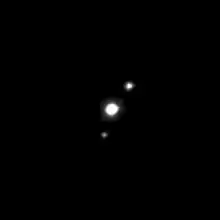 |
.jpg.webp) |
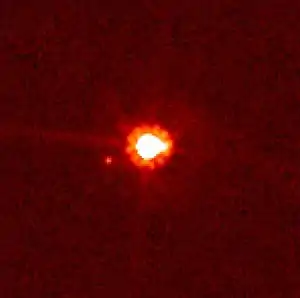 | ||
| Symbol[q] | ||||||
| Symbol (Unicode)[q] | ⚳ | ♇ or ⯓ | 🝻 | 🝼 | ⯰ | |
| Minor planet number | 1 | 134340 | 136108 | 136472 | 136199 | |
| Discovery year | 1801 | 1930 | 2004 | 2005 | 2005 | |
| Mean distance from the Sun |
km AU |
413,700,000 2.766 |
5,906,380,000 39.482 |
6,484,000,000 43.335 |
6,850,000,000 45.792 |
10,210,000,000 67.668 |
| Mean radius | km :E[f] |
473 0.0742 |
1,188.3[10] 0.186 |
816 (2100 × 1680 × 1074) 0.13[36][37] |
715 0.11[38] |
1,163 0.18[39] |
| Volume | km3 :E[f] |
4.21×108 0.00039[b] |
6.99×109 0.0065 |
1.98×109 0.0018 |
1.7×109 0.0016[b] |
6.59×109 0.0061[b] |
| Surface area | km2 :E[f] |
2,770,000 0.0054[a] |
17,700,000 0.035 |
8,140,000 0.016[y] |
6,900,000 0.0135[a] |
17,000,000 0.0333[a] |
| Mass | kg :E[f] |
9.39×1020 0.00016 |
1.30×1022 0.0022 |
4.01 ± 0.04×1021 0.0007[40] |
≈ 3.1×1021 0.0005 |
1.65×1022 0.0028 |
| Gravitational parameter | m3/s2 | 6.263 × 1010 | 8.710 × 1011 | 2.674 × 1011 | 2.069 × 1011 | 1.108 × 1012 |
| Density | g/cm3 | 2.16 | 1.87 | 2.02[36] | 2.03 | 2.43 |
| Equatorial gravity | m/s2 g |
0.27[d] 0.028 |
0.62 0.063 |
0.63[d] 0.064 |
0.40 0.041 |
0.82[d] 0.084 |
| Escape velocity | km/s[e] | 0.51 | 1.21 | 0.91 | 0.54 | 1.37 |
| Rotation period[g] | days | 0.3781 | 6.3872 | 0.1631 | 0.9511 | 14.560 |
| Orbital period[g] | years | 4.599 | 247.9 | 283.8 | 306.2 | 559 |
| Mean orbital speed | km/s | 17.882 | 4.75 | 4.48[o] | 4.40[o] | 3.44[n] |
| Eccentricity | 0.080 | 0.249 | 0.195 | 0.161 | 0.436 | |
| Inclination[f] | deg. | 10.59 | 17.14 | 28.21 | 28.98 | 44.04 |
| Axial tilt[i] | deg. | 4 | 119.6[h] | ≈126 | ? | ≈78 |
| Mean surface temperature[w] | K | 167[41] | 40[42] | <50[43] | 30 | 30 |
| Atmospheric composition | H2O | N2, CH4, CO | ? | N2, CH4[44] | N2, CH4[45] | |
| Number of known moons[v] | 0 | 5 | 2[46] | 1[47] | 1[48] | |
| Rings? | No | No | Yes | No? | No? | |
| Planetary discriminant[l][o] | 0.33 | 0.077 | 0.023 | 0.02 | 0.10 | |
Astronomers usually refer to solid bodies such as Ceres as dwarf planets, even if they are not strictly in hydrostatic equilibrium. They generally agree that several other trans-Neptunian objects may be large enough to be dwarf planets, given current uncertainties. However, there has been disagreement on the required size. Early speculations were based on the small moons of the giant planets, which attain roundness around a threshold of 200 km radius.[49] However, these moons are at higher temperatures than TNOs and are icier than TNOs are likely to be.
Many TNOs in the 200–500 km radius range are dark and low-density bodies, like 229762 Gǃkúnǁʼhòmdímà (radius 321±14 km) or (55637) 2002 UX25 (radius 332.5±14.5 km). They have densities too low to be solid mixtures of ice and rock, which the larger TNOs are. It was once considered that this was because they were predominantly icy like some moons of Saturn, but TNOs both above and below this size range contain significant rock fractions, and William Grundy et al. pointed out that there is no evolutionary mechanism that would allow large and small TNOs to be rocky while medium ones would not be. They hypothesise instead that medium-sized TNOs are also rocky, and have low densities because they retain internal porosity from their formation, and hence are not planetary bodies (as planetary bodies have sufficient gravitation to collapse out such porosity). Ice–rock mixtures at Kuiper belt temperatures are expected to be strong enough to support significant open spaces in objects up to 350 km radius. At 450 km radius, the interior might eventually start to collapse, but the process might not reach the surface, which would remain cold and uncompressed (as collapsing out porosity would shrink an object, likely differentiated objects now in this size range like Orcus were probably once even larger). Dark surfaces indicate that a body has never been resurfaced (in contrast to Orcus and Charon with bright, relatively clean water ice on their surfaces), and thus that it has at most incompletely differentiated (and might not have differentiated at all).[50] This is roughly in agreement with estimates from an IAU question-and-answer press release from 2006, giving 400 km radius and 0.5×1021 kg mass as cut-offs that normally would be enough for hydrostatic equilibrium, while stating that observation would be needed to determine the status of borderline cases.[51]
If this assessment is correct, then only the largest few TNOs could be dwarf planets.[50] This assessment considered 120347 Salacia (radius 423±10.5 km) and 174567 Varda (radius 370±7 km) to also be dark and low-density bodies; later studies suggest nonetheless that their densities might be higher, potentially high enough to be solid.[52][53]
The only known additional TNOs that have a radius greater than 450 km are Gonggong, Quaoar, Sedna, and probably Orcus. Lowering the cutoff to 400 km increases the certainty for Orcus, and adds Salacia and perhaps also (307261) 2002 MS4, though 2002 MS4's mass is unknown and Salacia's is just below the IAU Q&A's stated mass limit. Astronomers generally agree that the first four are dwarf planets, while disagreeing on smaller bodies. Gonggong, Orcus, and Quaoar have moons that have allowed their mass and density to be determined using Kepler's third law, and they are either bright enough (Orcus) to suggest resurfacing and thus planetary geology at least at some point in their past, or are dense enough (Gonggong and Quaoar) that they are clearly solid bodies and thus at least potentially dwarf planets. Sedna, which is bright but has unknown density, has been included as a strong additional candidate. Salacia, being the only other candidate known to be over 400 km radius, has been included as a sample object at the borderline: it is dark, but might be dense enough to be solid, and is above the IAU Q&A's cutoff radius and just below its cutoff mass.
| ‡Orcus[54] | ‡Salacia[55] | ‡Quaoar[56] | §Gonggong[57] | ×Sedna[58] | ||
|---|---|---|---|---|---|---|
 |
 |
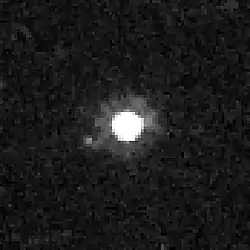 |
.png.webp) |
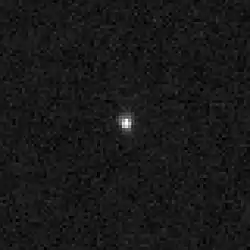 | ||
| Symbol[q] | ||||||
| Symbol (Unicode)[q] | 🝿 | 🝾 | 🝽 | ⯲ | ||
| Minor-planet number | 90482 | 120347 | 50000 | 225088 | 90377 | |
| Discovery year | 2004 | 2004 | 2002 | 2007 | 2003 | |
| Semi-major axis | km AU |
5,896,946,000 39.419 |
6,310,600,000 42.18 |
6,535,930,000 43.69 |
10,072,433,340 67.33 |
78,668,000,000 525.86 |
| Mean radius[s] | km :E[f] |
458.5[59] 0.0720 |
423[52] 0.0664 |
560.5[60] 0.0870 |
615[61] 0.0982 |
497.5[62] 0.0780 |
| Surface area[a] | km2 :E[f] |
2,641,700 0.005179 |
2,248,500 0.004408 |
3,948,000 0.007741 |
4,932,300 0.009671 |
3,110,200 0.006098 |
| Volume[b] | km3 :E[f] |
403,744,500 0.000373 |
317,036,800 0.000396 |
737,591,000 0.000681 |
1,030,034,600 0.000951 |
515,784,000 0.000476 |
| Mass[t] | kg :E[f] |
6.32×1020[63] 0.0001 |
4.9×1020[52] 0.0001 |
1.41×1021[64] 0.0003 |
1.75×1021[61] 0.0003 |
? |
| Density[t] | g/cm3 | 1.5±0.3[63] | 1.50±0.12[52] | 1.99±0.46[64] | 1.74±0.16 | ? |
| Equatorial gravity[d] | m/s2 g |
0.27 0.028 |
0.18 0.018 |
0.24 0.024 |
0.285 0.029 |
? |
| Escape velocity[e] | km/s | 0.50 | 0.39 | 0.45 | 0.604 | ? |
| Rotation period[g] | days | ? | ? | 0.3683 | 0.9333 | 0.4280[65] |
| Orbital period[g] | years | 247.49 | 273.98 | 287.97 | 552.52 | 12,059 |
| Mean orbital speed | km/s | 4.68 | 4.57 | 4.52 | 3.63 | 1.04 |
| Eccentricity | 0.226 | 0.106 | 0.038 | 0.506 | 0.855 | |
| Inclination[f] | deg. | 20.59 | 23.92 | 7.99 | 30.74 | 11.93 |
| Mean surface temperature[w] | K | ~42 | ~43 | ~41 | ~30 | ~12 |
| Number of known moons | 1[66] | 1 | 1[67] | 1 | 0 | |
| Planetary discriminant[l][o] | 0.003 | <0.1 | 0.0015 | <0.1 | ?[x] | |
| Absolute magnitude (H) | 2.3 | 4.1 | 2.71 | 1.8 | 1.5 | |
As for objects in the asteroid belt, none are generally agreed as dwarf planets today among astronomers other than Ceres. The second- through fifth-largest asteroids have been discussed as candidates. Vesta (radius 262.7±0.1 km), the second-largest asteroid, appears to have a differentiated interior and therefore likely was once a dwarf planet, but it is no longer very round today.[68] Pallas (radius 255.5±2 km), the third-largest asteroid, appears never to have completed differentiation and likewise has an irregular shape. Vesta and Pallas are nonetheless sometimes considered small terrestrial planets anyway by sources preferring a geophysical definition, because they do share similarities to the rocky planets of the inner solar system.[69] The fourth-largest asteroid, Hygiea (radius 216.5±4 km), is icy. The question remains open if it is currently in hydrostatic equilibrium: while Hygiea is round today, it was probably previously catastrophically disrupted and today might be just a gravitational aggregate of the pieces.[70] The fifth-largest asteroid, Interamnia (radius 166±3 km), is icy and has a shape consistent with hydrostatic equilibrium for a slightly shorter rotation period than it now has.[71]
Satellites
| Key | ||||||
|---|---|---|---|---|---|---|
| 🜨 Satellite of Earth |
♃ Satellite of Jupiter |
♄ Satellite of Saturn |
⛢ Satellite of Uranus |
♆ Satellite of Neptune |
♇ Satellite of Pluto | |
There are at least 19 natural satellites in the Solar System that are known to be massive enough to be close to hydrostatic equilibrium: seven of Saturn, five of Uranus, four of Jupiter, and one each of Earth, Neptune, and Pluto. Alan Stern calls these satellite planets, although the term major moon is more common. The smallest natural satellite that is gravitationally rounded is Saturn I Mimas (radius 198.2±0.4 km). This is smaller than the largest natural satellite that is known not to be gravitationally rounded, Neptune VIII Proteus (radius 210±7 km).
Several of these were once in equilibrium but are no longer: these include Earth's moon[72] and all of the moons listed for Saturn apart from Titan and Rhea.[73] The status of Callisto and Rhea is uncertain, as is that of the moons of Uranus and Pluto.[25] The other large moons (Io, Europa, Ganymede, Titan, and Triton) are generally believed to still be in equilibrium today. Other moons that were once in equilibrium but are no longer very round, such as Saturn IX Phoebe (radius 106.5±0.7 km), are not included.
The satellites of Eris (Dysnomia) and Orcus (Vanth) are larger than Mimas: Dysnomia falls between Tethys and Enceladus in size, and Vanth is around the size of Proteus. However, they are not included in the tables as too little is known about them. They are dark bodies in the size range which should allow for internal porosity.[50]
Satellites are listed first in order from the Sun, and second in order from their parent body. For the round moons, this mostly matches the Roman numeral designations, with the exceptions of Iapetus and the Uranian system. This is because the Roman numeral designations originally reflected distance from the parent planet and were updated for each new discovery until 1851, but by 1892, the numbering system for the then-known satellites had become "frozen" and from then on followed order of discovery. Thus Miranda (discovered 1948) is Uranus V despite being the innermost of Uranus' five round satellites. The missing Saturn VII is Hyperion, which is not large enough to be round (mean radius 135±4 km).
| 🜨Moon[74] | ♃Io[75] | ♃Europa[76] | ♃Ganymede[77] | ♃Callisto[78] | ♄Mimas[p] | ♄Enceladus[p] | ♄Tethys[p] | ♄Dione[p] | ♄Rhea[p] | ||
|---|---|---|---|---|---|---|---|---|---|---|---|
 |
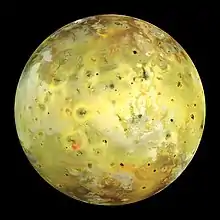 |
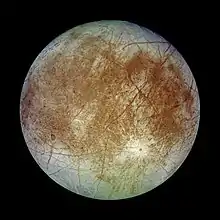 |
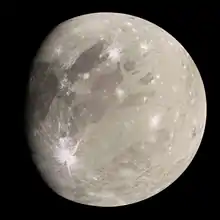 |
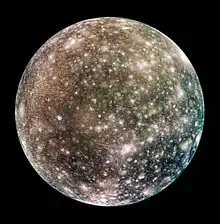 |
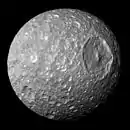 |
 |
 |
.jpg.webp) |
 | ||
| Roman numeral designation | Earth I | Jupiter I | Jupiter II | Jupiter III | Jupiter IV | Saturn I | Saturn II | Saturn III | Saturn IV | Saturn V | |
| Symbol[q] | |||||||||||
| Symbol (Unicode)[q] | ☾ | ||||||||||
| Discovery year | Prehistoric | 1610 | 1610 | 1610 | 1610 | 1789 | 1789 | 1684 | 1684 | 1672 | |
| Mean distance from primary: |
km | 384,399 | 421,600 | 670,900 | 1,070,400 | 1,882,700 | 185,520 | 237,948 | 294,619 | 377,396 | 527,108 |
| Mean radius | km :E[f] |
1,737.1 0.272 |
1,815 0.285 |
1,569 0.246 |
2,634.1 0.413 |
2,410.3 0.378 |
198.30 0.031 |
252.1 0.04 |
533 0.084 |
561.7 0.088 |
764.3 0.12 |
| Surface area[a] | 1×106 km2 | 37.93 | 41.910 | 30.9 | 87.0 | 73 | 0.49 | 0.799 | 3.57 | 3.965 | 7.337 |
| Volume[b] | 1×109 km3 | 22 | 25.3 | 15.9 | 76 | 59 | 0.033 | 0.067 | 0.63 | 0.8 | 1.9 |
| Mass | 1×1022 kg | 7.3477 | 8.94 | 4.80 | 14.819 | 10.758 | 0.00375 | 0.0108 | 0.06174 | 0.1095 | 0.2306 |
| Density[c] | g/cm3 | 3.3464 | 3.528 | 3.01 | 1.936 | 1.83 | 1.15 | 1.61 | 0.98 | 1.48 | 1.23 |
| Equatorial gravity[d] | m/s2 g |
1.622 0.1654 |
1.796 0.1831 |
1.314 0.1340 |
1.428 0.1456 |
1.235 0.1259 |
0.0636 0.00649 |
0.111 0.0113 |
0.145 0.0148 |
0.231 0.0236 |
0.264 0.0269 |
| Escape velocity[e] | km/s | 2.38 | 2.56 | 2.025 | 2.741 | 2.440 | 0.159 | 0.239 | 0.393 | 0.510 | 0.635 |
| Rotation period | days[g] | 27.321582 (sync)[m] |
1.7691378 (sync) |
3.551181 (sync) |
7.154553 (sync) |
16.68902 (sync) |
0.942422 (sync) |
1.370218 (sync) |
1.887802 (sync) |
2.736915 (sync) |
4.518212 (sync) |
| Orbital period about primary | days[g] | 27.32158 | 1.769138 | 3.551181 | 7.154553 | 16.68902 | 0.942422 | 1.370218 | 1.887802 | 2.736915 | 4.518212 |
| Mean orbital speed[o] | km/s | 1.022 | 17.34 | 13.740 | 10.880 | 8.204 | 14.32 | 12.63 | 11.35 | 10.03 | 8.48 |
| Eccentricity | 0.0549 | 0.0041 | 0.009 | 0.0013 | 0.0074 | 0.0202 | 0.0047 | 0.02 | 0.002 | 0.001 | |
| Inclination to primary's equator | deg. | 18.29–28.58 | 0.04 | 0.47 | 1.85 | 0.2 | 1.51 | 0.02 | 1.51 | 0.019 | 0.345 |
| Axial tilt[i][u] | deg. | 6.68 | 0.000405 ± 0.00076[79] | 0.0965 ± 0.0069[79] | 0.155 ± 0.065[79] | ≈0–2[79][aa] | ≈0 | ≈0 | ≈0 | ≈0 | ≈0 |
| Mean surface temperature[w] | K | 220 | 130 | 102 | 110[80] | 134 | 64 | 75 | 64 | 87 | 76 |
| Atmospheric composition | Ar, He Na, K, H |
SO2[81] | O2[82] | O2[83] | O2, CO2[84] | H2O, N2 CO2, CH4[85] |
|||||
| ♄Titan[p] | ♄Iapetus[p] | ⛢Miranda[r] | ⛢Ariel[r] | ⛢Umbriel[r] | ⛢Titania[r] | ⛢Oberon[r] | ♆Triton[86] | ♇Charon[28] | ||
|---|---|---|---|---|---|---|---|---|---|---|
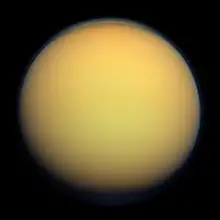 |
 |
 |
.jpg.webp) |
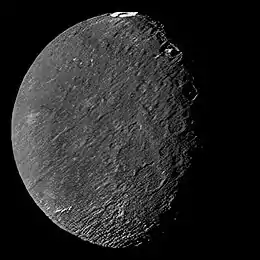 |
_color%252C_cropped.jpg.webp) |
 |
 |
 | ||
| Roman numeral designation | Saturn VI | Saturn VIII | Uranus V | Uranus I | Uranus II | Uranus III | Uranus IV | Neptune I | Pluto I | |
| Discovery year | 1655 | 1671 | 1948 | 1851 | 1851 | 1787 | 1787 | 1846 | 1978 | |
| Mean distance from primary: |
km | 1,221,870 | 3,560,820 | 129,390 | 190,900 | 266,000 | 436,300 | 583,519 | 354,759 | 17,536 |
| Mean radius | km :E[f] |
2,576 0.404 |
735.60 0.115 |
235.8 0.037 |
578.9 0.091 |
584.7 0.092 |
788.9 0.124 |
761.4 0.119 |
1,353.4 0.212 |
603.5 0.095 |
| Surface area[a] | 1×106 km2 | 83.0 | 6.7 | 0.70 | 4.211 | 4.296 | 7.82 | 7.285 | 23.018 | 4.580 |
| Volume[b] | 1×109 km3 | 71.6 | 1.67 | 0.055 | 0.81 | 0.84 | 2.06 | 1.85 | 10 | 0.92 |
| Mass | 1×1022 kg | 13.452 | 0.18053 | 0.00659 | 0.135 | 0.12 | 0.35 | 0.3014 | 2.14 | 0.152 |
| Density[c] | g/cm3 | 1.88 | 1.08 | 1.20 | 1.67 | 1.40 | 1.72 | 1.63 | 2.061 | 1.65 |
| Equatorial gravity[d] | m/s2 g |
1.35 0.138 |
0.22 0.022 |
0.08 0.008 |
0.27 0.028 |
0.23 0.023 |
0.39 0.040 |
0.35 0.036 |
0.78 0.080 |
0.28 0.029 |
| Escape velocity[e] | km/s | 2.64 | 0.57 | 0.19 | 0.56 | 0.52 | 0.77 | 0.73 | 1.46 | 0.58 |
| Rotation period | days[g] | 15.945 (sync)[m] |
79.322 (sync) |
1.414 (sync) |
2.52 (sync) |
4.144 (sync) |
8.706 (sync) |
13.46 (sync) |
5.877 (sync) |
6.387 (sync) |
| Orbital period about primary | days | 15.945 | 79.322 | 1.4135 | 2.520 | 4.144 | 8.706 | 13.46 | 5.877 | 6.387 |
| Mean orbital speed[o] | km/s | 5.57 | 3.265 | 6.657 | 5.50898 | 4.66797 | 3.644 | 3.152 | 4.39 | 0.2 |
| Eccentricity | 0.0288 | 0.0286 | 0.0013 | 0.0012 | 0.005 | 0.0011 | 0.0014 | 0.00002 | 0.0022 | |
| Inclination to primary's equator | deg. | 0.33 | 14.72 | 4.22 | 0.31 | 0.36 | 0.14 | 0.10 | 157[h] | 0.001 |
| Axial tilt[i][u] | deg. | ≈0.3[87] | ≈0 | ≈0 | ≈0 | ≈0 | ≈0 | ≈0 | ≈0.7[88] | ≈0 |
| Mean surface temperature[w] | K | 93.7[89] | 130 | 59 | 58 | 61 | 60 | 61 | 38[90] | 53 |
| Atmospheric composition | N2, CH4[91] | N2, CH4[92] | ||||||||
See also
- List of Solar System objects by size
- Lists of astronomical objects
- List of former planets
- Planetary-mass object
Notes
Unless otherwise cited:[z]
- ^ The planetary discriminant for the planets is taken from material published by Stephen Soter.[93] Planetary discriminants for Ceres, Pluto and Eris taken from Soter, 2006. Planetary discriminants of all other bodies calculated from the Kuiper belt mass estimate given by Lorenzo Iorio.[94]
- ^ Saturn satellite info taken from NASA Saturnian Satellite Fact Sheet.[95]
- ^ With the exception of the Sun and Earth symbols, astronomical symbols are mostly used by astrologers today; although occasional use of the other planet symbols (and Pluto) in astronomical contexts still exists,[96] it is officially discouraged.[97]
Astronomical symbols for the Sun, the planets (first symbol for Uranus), and the Moon, as well as the first symbol for Pluto were taken from NASA Solar System Exploration.[98] The other symbols are even rarer in modern astronomy.
- The symbol for Ceres was taken from material published by James L. Hilton; it was used astronomically when Ceres was thought to be a major planet, and continues to be used today in astrology.[99]
- The second symbol for Uranus was also taken from there; it is more common in astrology than the first symbol.[99]
- The symbols for Haumea, Makemake, and Eris appear in a NASA JPL infographic, as does the second symbol for Pluto;[100] they are otherwise mostly astrological symbols.
- The symbols for Quaoar, Sedna, Orcus, and Gonggong were taken from Unicode;[101] so far they have only been used in astrology.
- The symbol for Salacia was taken from a Unicode proposal, but is not encoded in the Unicode Standard. It has yet to receive widespread adoption amongst astronomers or astrologers.[101]
- ^ Uranus satellite info taken from NASA Uranian Satellite Fact Sheet.[102]
- ^ Radii for plutoid candidates taken from material published by John A. Stansberry et al.[39]
- ^ Axial tilts for most satellites assumed to be zero in accordance with the Explanatory Supplement to the Astronomical Almanac: "In the absence of other information, the axis of rotation is assumed to be normal to the mean orbital plane."[103]
- ^ Natural satellite numbers taken from material published by Scott S. Sheppard.[104]
Manual calculations (unless otherwise cited)
- ^ Surface area A derived from the radius using , assuming sphericity.
- ^ Volume V derived from the radius using , assuming sphericity.
- ^ Density derived from the mass divided by the volume.
- ^ Surface gravity derived from the mass m, the gravitational constant G and the radius r: Gm/r2.
- ^ Escape velocity derived from the mass m, the gravitational constant G and the radius r: √(2Gm)/r.
- ^ Orbital speed is calculated using the mean orbital radius and the orbital period, assuming a circular orbit.
- ^ Assuming a density of 2.0
- ^ Calculated using the formula where Teff = 54.8 K at 52 AU, is the geometric albedo, q = 0.8 is the phase integral, and is the distance from the Sun in AU. This formula is a simplified version of that in section 2.2 of Stansberry et al., 2007,[39] where emissivity and beaming parameter were assumed to equal unity, and was replaced with 4 accounting for the difference between circle and sphere. All parameters mentioned above were taken from the same paper.
Individual calculations
- ^ Surface area was calculated using the formula for a scalene ellipsoid:
- where is the modular angle, or angular eccentricity; and , are the incomplete elliptic integrals of the first and second kind, respectively. The values 980 km, 759 km, and 498 km were used for a, b, and c respectively.
Other notes
- ^ Relative to Earth
- ^ Sidereal
- ^ Retrograde
- ^ The inclination of the body's equator from its orbit.
- ^ At pressure of 1 bar
- ^ At sea level
- ^ The ratio between the mass of the object and those in its immediate neighborhood. Used to distinguish between a planet and a dwarf planet.
- ^ This object's rotation is synchronous with its orbital period, meaning that it only ever shows one face to its primary.
- ^ Objects' planetary discriminants based on their similar orbits to Eris. Sedna's population is currently too little-known for a planetary discriminant to be determined.
- ^ "Unless otherwise cited" means that the information contained in the citation is applicable to an entire line or column of a chart, unless another citation specifically notes otherwise. For example, Titan's mean surface temperature is cited to the reference in its cell; it is not calculated like the temperatures of most of the other satellites here, because it has an atmosphere that makes the formula inapplicable.
- ^ Callisto's axial tilt varies between 0 and about 2 degrees on timescales of thousands of years.[79]
References
- Woolfson, Michael Mark (2000). "The Origin and Evolution of the Solar System". Astronomy & Geophysics. 41 (1): 1.12–1.19. Bibcode:2000A&G....41a..12W. doi:10.1046/j.1468-4004.2000.00012.x.
- NASA Solar System exploration Sun factsheet Archived 2008-01-02 at the Wayback Machine and NASA Sun factsheet Archived 2010-07-15 at the Wayback Machine NASA Retrieved on 2008-11-17 (unless otherwise cited)
- "By the Numbers | Sun - NASA Solar System Exploration". NASA.
- Leong, Stacy (2002). Elert, Glenn (ed.). "Period of the Sun's Orbit around the Galaxy (Cosmic Year)". The Physics Factbook (self-published). Retrieved 2008-06-26.
- Aschwanden, Markus J. (2007). "The Sun". In McFadden, Lucy Ann; Weissman, Paul R.; Johnsson, Torrence V. (eds.). Encyclopedia of the Solar System. Academic Press. p. 80.
- "IAU 2006 General Assembly: Result of the IAU Resolution votes" (Press release). International Astronomical Union. 24 August 2006. news release IAU0603. Archived from the original on 3 January 2007. Retrieved 31 December 2007. ("original IAU news release link". Archived from the original on 2008-02-05. Retrieved 2008-10-06.)
- Solomon, Sean; Nittler, Larry; Anderson, Brian (20 December 2018). Mercury: The View after MESSENGER. Cambridge Planetary Science Series. Cambridge University Press. pp. 72–73. ISBN 9781107154452.
- "NASA Mercury Fact Sheet". NASA. Archived from the original on 6 November 2015. Retrieved 17 November 2008.
- "NASA Solar System Exploration Factsheet". NASA. Archived from the original on 24 February 2004. Retrieved 17 November 2008.
- "Planets and Pluto: Physical Characteristics". JPL, NASA.
- "NASA Venus Factsheet". NASA. Archived from the original on 8 March 2016. Retrieved 17 November 2008.
- "NASA Solar System Exploration Factsheet". NASA. Archived from the original on 29 September 2006. Retrieved 17 November 2008.
- "NASA Earth factsheet". NASA. Retrieved 17 November 2008.
- "NASA Solar System Exploration Factsheet". NASA. Archived from the original on 27 August 2009. Retrieved 17 November 2008.
- "NASA Mars Factsheet". NASA. Archived from the original on 12 June 2010. Retrieved 17 November 2008.
- "NASA Mars Solar System Exploration Factsheet". NASA. Archived from the original on 23 January 2004. Retrieved 17 November 2008.
- "NASA Jupiter factsheet". NASA. Archived from the original on 13 October 2011. Retrieved 17 November 2008.
- "NASA Solar System Exploration Factsheet". NASA. Archived from the original on 15 December 2003. Retrieved 17 November 2008.
- "NASA Saturn factsheet". NASA. Archived from the original on 18 August 2011. Retrieved 17 November 2008.
- "NASA Solar System Exploration Saturn Factsheet". NASA. Archived from the original on 24 February 2004. Retrieved 17 November 2008.
- "NASA Uranus Factsheet". NASA. Archived from the original on 4 August 2011. Retrieved 17 November 2008.
- "NASA Solar System Exploration Uranus Factsheet". NASA. Archived from the original on 14 December 2003. Retrieved 17 November 2008.
- "NASA Neptune Factsheet". NASA. Retrieved 17 November 2008.
- "NASA Solar System Exploration Neptune Factsheet". NASA. Archived from the original on 15 December 2003. Retrieved 17 November 2008.
- Nimmo, Francis; et al. (2017). "Mean radius and shape of Pluto and Charon from New Horizons images". Icarus. 287: 12–29. arXiv:1603.00821. Bibcode:2017Icar..287...12N. doi:10.1016/j.icarus.2016.06.027. S2CID 44935431.
- Raymond, C.; Castillo-Rogez, J.C.; Park, R.S.; Ermakov, A.; et al. (September 2018). "Dawn Data Reveal Ceres' Complex Crustal Evolution" (PDF). European Planetary Science Congress. Vol. 12.
- "NASA Asteroid Factsheet". NASA. Archived from the original on 16 January 2010. Retrieved 17 November 2008.
- "NASA Pluto factsheet". NASA. Retrieved 17 November 2008.
- "NASA Solar System Exploration Pluto Factsheet". NASA. Archived from the original on 24 February 2004. Retrieved 17 November 2008.
- Lockwood, Alexandra C.; Brown, Michael E.; Stansberry, John A. (2014). "The Size and Shape of the Oblong Dwarf Planet Haumea". Earth, Moon, and Planets. 111 (3–4): 127–137. arXiv:1402.4456. Bibcode:2014EM&P..111..127L. doi:10.1007/s11038-014-9430-1. S2CID 18646829.
- Rabinowitz, David L.; Barkume, Kristina M.; Brown, Michael E.; Roe, Henry G.; Schwartz, Michael; Tourtellotte, Suzanne W.; Trujillo, Chadwick A. (2006). "Photometric Observations Constraining the Size, Shape, and Albedo of 2003 EL61, a rapidly rotating, Pluto-sized object in the Kuiper Belt". The Astrophysical Journal. 639 (2): 1238–1251. arXiv:astro-ph/0509401. Bibcode:2006ApJ...639.1238R. doi:10.1086/499575. S2CID 11484750.
- "Jet Propulsion Laboratory Small-Body Database Browser: 136108 Haumea". NASA's Jet Propulsion Laboratory. Retrieved 13 November 2008.
2008-05-10 last obs.
- Buie, Marc W. (5 April 2008). "Orbit fit and astrometric record for 136472". Space Science Department. SwRI. Retrieved 13 July 2008.
- "NASA Small Bodies Database Browser: 136472 Makemake (2005 FY9)". NASA JPL. Retrieved 2008-10-03. (unless otherwise cited)
- "NASA Small Body Database Browser: Eris". NASA JPL. Retrieved 2008-11-13. (unless otherwise cited)
- Dunham, E. T.; Desch, S. J.; Probst, L. (April 2019). "Haumea's Shape, Composition, and Internal Structure". The Astrophysical Journal. 877 (1): 11. arXiv:1904.00522. Bibcode:2019ApJ...877...41D. doi:10.3847/1538-4357/ab13b3. S2CID 90262114.
- Ortiz, J. L.; Santos-Sanz, P.; Sicardy, B.; Benedetti-Rossi, G.; Bérard, D.; Morales, N.; et al. (2017). "The size, shape, density and ring of the dwarf planet Haumea from a stellar occultation". Nature. 550 (7675): 219–223. arXiv:2006.03113. Bibcode:2017Natur.550..219O. doi:10.1038/nature24051. hdl:10045/70230. PMID 29022593. S2CID 205260767.
- Brown, Michael E. (2013). "On the size, shape, and density of dwarf planet Makemake". The Astrophysical Journal. 767 (1): L7. arXiv:1304.1041. Bibcode:2013ApJ...767L...7B. doi:10.1088/2041-8205/767/1/L7. S2CID 12937717.
- Stansberry, John A.; Grundy, Will M.; Brown, Michael E.; Cruikshank, Dale P.; Spencer, John; Trilling, David; Margot, Jean-Luc (2007). "Physical Properties of Kuiper Belt and Centaur Objects: Constraints from Spitzer Space Telescope". The Solar System Beyond Neptune: 161. arXiv:astro-ph/0702538. Bibcode:2008ssbn.book..161S.
- Brown, Michael E.; Bouchez, Antonin H.; Rabinowitz, David L.; Sari, Re'em; Trujillo, Chadwick A.; van Dam, Marcos A.; et al. (October 2005). "Keck Observatory laser guide star adaptive optics discovery and characterization of a satellite to large Kuiper belt object 2003 EL61" (PDF). The Astrophysical Journal Letters. 632 (L45): L45. Bibcode:2005ApJ...632L..45B. doi:10.1086/497641. S2CID 119408563.
- Saint-Pé, Olivier; Combes, Michel; Rigaut, François J. (1993). "Ceres surface properties by high-resolution imaging from Earth". Icarus. 105 (2): 271–281. Bibcode:1993Icar..105..271S. doi:10.1006/icar.1993.1125.
- Than, Ker (2006). "Astronomers: Pluto colder than expected". Space.com. Retrieved 5 March 2006 – via CNN.
- Trujillo, Chadwick A.; Brown, Michael E.; Barkume, Kristina M.; Schaller, Emily L.; Rabinowitz, David L. (February 2007). "The Surface of 2003 EL61 in the Near Infrared". The Astrophysical Journal. 655 (2): 1172–1178. arXiv:astro-ph/0601618. Bibcode:2007ApJ...655.1172T. doi:10.1086/509861. S2CID 118938812.
- Brown, Michael E.; Barkume, Kristina M.; Blake, Geoffrey A.; Schaller, Emily L.; Rabinowitz, David L.; Roe, Henry G.; Trujillo, Chadwick A. (2007). "Methane and Ethane on the Bright Kuiper Belt Object 2005 FY9" (PDF). The Astronomical Journal. 133 (1): 284–289. Bibcode:2007AJ....133..284B. doi:10.1086/509734. S2CID 12146168.
- Licandro, Javier; Grundy, Will M.; Pinilla-Alonso, Noemi; de Leon, Jerome P. (2006). "Visible spectroscopy of 2003 UB313: evidence for N2 ice on the surface of the largest TNO?" (PDF). Astronomy and Astrophysics. 458 (1): L5–L8. arXiv:astro-ph/0608044. Bibcode:2006A&A...458L...5L. CiteSeerX 10.1.1.257.1298. doi:10.1051/0004-6361:20066028. S2CID 31587702.
- Ragozzine, Darin; Brown, Michael E.; Trujillo, Chadwick A.; Schaller, Emily L. Orbits and Masses of the 2003 EL61 Satellite System. AAS DPS conference 2008. Archived from the original on 18 July 2013. Retrieved 17 October 2008.
- Chang, Kenneth (26 April 2016). "Makemake, the Moonless Dwarf Planet, Has a Moon, After All". The New York Times. Retrieved 26 April 2016.
- Brown, Michael E.; van Dam, Marcos A.; Bouchez, Antonin H.; Le Mignant, David; Trujillo, Chadwick A.; Campbell, Randall D.; et al. (2006). "Satellites of the largest Kuiper belt objects". The Astrophysical Journal. 639 (1): L43–L46. arXiv:astro-ph/0510029. Bibcode:2006ApJ...639L..43B. doi:10.1086/501524. S2CID 2578831.
- Mike Brown. "The Dwarf Planets". Retrieved 2008-01-20.
- Grundy, W.M.; Noll, K.S.; Buie, M.W.; Benecchi, S.D.; Ragozzine, D.; Roe, H.G. (2019). "The mutual orbit, mass, and density of trans-Neptunian binary Gǃkúnǁʼhòmdímà ((229762) 2007 UK126)". Icarus. 334: 30–38. doi:10.1016/j.icarus.2018.12.037. S2CID 126574999. Archived from the original on 2019-04-07. Retrieved 2019-04-11.
- "'Planet Definition' Questions & Answers Sheet". International Astronomical Union. August 24, 2006. Retrieved October 16, 2021.
- Grundy, W. M.; Noll, K. S.; Roe, H. G.; Buie, M. W.; Porter, S. B.; Parker, A. H.; Nesvorný, D.; Benecchi, S. D.; Stephens, D. C.; Trujillo, C. A. (2019). "Mutual Orbit Orientations of Transneptunian Binaries" (PDF). Icarus. 334: 62–78. Bibcode:2019Icar..334...62G. doi:10.1016/j.icarus.2019.03.035. ISSN 0019-1035. S2CID 133585837. Archived from the original (PDF) on 2020-01-15. Retrieved 2019-10-26.
- Souami, D.; Braga-Ribas, F.; Sicardy, B.; Morgado, B.; Ortiz, J. L.; Desmars, J.; et al. (August 2020). "A multi-chord stellar occultation by the large trans-Neptunian object (174567) Varda". Astronomy & Astrophysics. 643: A125. arXiv:2008.04818. Bibcode:2020A&A...643A.125S. doi:10.1051/0004-6361/202038526. S2CID 221095753.
- "JPL Small-Body Database Browser: 90482 Orcus (2004 DW)" (2020-01-04 last obs). Jet Propulsion Laboratory. Retrieved 20 February 2020.
- "JPL Small-Body Database Browser: 120347 Salacia (2004 SB60)" (2019-09-21 last obs). Jet Propulsion Laboratory. Retrieved 20 February 2020.
- "NASA JPL Database Browser: 50000 Quaoar" (2019-08-31 last obs). Jet Propulsion Laboratory. Retrieved 20 February 2020.
- "NASA Small Bodies Database Browser: 225088 Gonggong (2007 OR10)". Jet Propulsion Laboratory. Retrieved 20 February 2020.
- Buie, Marc W. (13 August 2007). "Orbit Fit and Astrometric record for 90377". Deep Ecliptic Survey. Retrieved 17 January 2006.
- Fornasier, Sonia; Lellouch, Emmanuel; Müller, Thomas G.; Santos-Sanz, Pablo; Panuzzo, Pasquale; Kiss, Csaba; et al. (2013). "TNOs are Cool: A survey of the trans-Neptunian region. VIII. Combined Herschel PACS and SPIRE observations of 9 bright targets at 70–500 µm". Astronomy & Astrophysics. 555: A15. arXiv:1305.0449. Bibcode:2013A&A...555A..15F. doi:10.1051/0004-6361/201321329. S2CID 119261700.
- Arimatsu, Ko; Ohsawa, Ryou; Hashimoto, George L.; Urakawa, Seitaro; Takahashi, Jun; Tozuka, Miyako; et al. (October 2019). "New constraint on the atmosphere of (50000) Quaoar from a stellar occultation". The Astronomical Journal. 158 (6): 236. arXiv:1910.09988. doi:10.3847/1538-3881/ab5058. S2CID 204823847.
- Kiss, Csaba; Marton, Gabor; Parker, Alex H.; Grundy, Will; Farkas-Takacs, Aniko; Stansberry, John; et al. (13 March 2019), "The mass and density of the dwarf planet (225088) 2007 OR10", Icarus, 334: 3–10, arXiv:1903.05439, doi:10.1016/j.icarus.2019.03.013, S2CID 119370310
- Pál, A.; Kiss, C.; Müller, T.G.; Santos-Sanz, P.; Vilenius, E.; Szalai, N.; Mommert, M.; Lellouch, E.; Rengel, M.; Hartogh, P.; Protopapa, S.; Stansberry, J.; Ortiz, J.-L.; Duffard, R.; Thirouin, A.; Henry, F.; Delsanti, A. (2012). ""TNOs are Cool": A survey of the trans-Neptunian region. VII. Size and surface characteristics of (90377) Sedna and 2010 EK139". Astronomy & Astrophysics. 541: L6. arXiv:1204.0899. Bibcode:2012A&A...541L...6P. doi:10.1051/0004-6361/201218874. S2CID 119117186.
- Brown, Michael E.; Ragozzine, Darin; Stansberry, John A.; Fraser, Wesley C. (2009). "The size, density, and formation of the Orcus-Vanth system in the Kuiper belt". Astronomical Journal. 139 (6): 2700. arXiv:0910.4784. Bibcode:2010AJ....139.2700B. doi:10.1088/0004-6256/139/6/2700. S2CID 8864460.
- Braga-Ribas, F.; Sicardy, B.; Ortiz, J. L.; Lellouch, E.; Tancredi, G.; Lecacheux, J.; et al. (August 2013). "The Size, Shape, Albedo, Density, and Atmospheric Limit of Transneptunian Object (50000) Quaoar from Multi-chord Stellar Occultations". The Astrophysical Journal. 773 (1): 13. Bibcode:2013ApJ...773...26B. doi:10.1088/0004-637X/773/1/26. hdl:11336/1641. S2CID 53724395.
- "JPL Small-Body Database Browser: 90377 Sedna (2003 VB12)" (2016-01-12 last obs). Retrieved 28 May 2019.
- "Distant EKO". The Kuiper Belt Electronic newsletter. March 2007. Retrieved 17 November 2008.
- "IAUC 8812: Sats of 2003 AZ_84, (50000), (55637), (90482); V1281 Sco; V1280 Sco". International Astronomical Union. Retrieved 5 July 2011.
- Savage, Don; Jones, Tammy; Villard, Ray (19 April 1995). "Asteroid or mini-planet? Hubble maps the ancient surface of Vesta". HubbleSite (Press release). News Release STScI-1995-20. Retrieved 17 October 2006.
- Emily Lakdawalla et al., What Is A Planet? The Planetary Society, 21 April 2020
- Vernazza, P.; Jorda, L.; Ševeček, P.; Brož, M.; Viikinkoski, M.; Hanuš, J.; et al. (2020). "A basin-free spherical shape as an outcome of a giant impact on asteroid Hygiea" (PDF). Nature Astronomy. 273 (2): 136–141. Bibcode:2020NatAs...4..136V. doi:10.1038/s41550-019-0915-8. hdl:10045/103308. S2CID 209938346. Retrieved 2019-10-28.
- Hanuš, J.; Vernazza, P.; Viikinkoski, M.; Ferrais, M.; Rambaux, N.; Podlewska-Gaca, E.; Drouard, A.; Jorda, L.; Jehin, E.; Carry, B.; Marsset, M.; Marchis, F.; Warner, B.; Behrend, R.; Asenjo, V.; Berger, N.; Bronikowska, M.; Brothers, T.; Charbonnel, S.; Colazo, C.; Coliac, J.-F.; Duffard, R.; Jones, A.; Leroy, A.; Marciniak, A.; Melia, R.; Molina, D.; Nadolny, J.; Person, M.; et al. (2020). "(704) Interamnia: A transitional object between a dwarf planet and a typical irregular-shaped minor body". Astronomy & Astrophysics. 633: A65. arXiv:1911.13049. Bibcode:2020A&A...633A..65H. doi:10.1051/0004-6361/201936639. S2CID 208512707.
- Runcorn, Stanley Keith (March 31, 1977). "Interpretation of lunar potential fields". Philosophical Transactions of the Royal Society of London. Series A, Mathematical and Physical Sciences. 285 (1327): 507–516. Bibcode:1977RSPTA.285..507R. doi:10.1098/rsta.1977.0094. S2CID 124703189.
- P.C. Thomas (2010) 'Sizes, shapes, and derived properties of the saturnian satellites after the Cassini nominal mission', Icarus 208: 395–401
- NASA Moon factsheet and NASA Solar System Exploration Moon Factsheet NASA Retrieved on 2008-11-17 (unless otherwise cited)
- "NASA Io Factsheet". NASA. Archived from the original on 1999-04-22. Retrieved 2008-11-16. (unless otherwise cited)
- "NASA Europa Factsheet". NASA. Archived from the original on 1997-01-05. Retrieved 2008-11-16. (unless otherwise cited)
- "NASA Ganymede Factsheet". NASA. Archived from the original on 1997-01-05. Retrieved 2008-11-16. (unless otherwise cited)
- "NASA Callisto Factsheet". NASA. Archived from the original on 1997-01-05. Retrieved 2008-11-16.
- Bills, Bruce G. (2005). "Free and forced obliquities of the Galilean satellites of Jupiter". Icarus. 175 (1): 233–247. Bibcode:2005Icar..175..233B. doi:10.1016/j.icarus.2004.10.028.
- Orton, Glenn S.; Spencer, John R.; Travis, Larry D.; et al. (1996). "Galileo Photopolarimeter-radiometer observations of Jupiter and the Galilean Satellites". Science. 274 (5286): 389–391. Bibcode:1996Sci...274..389O. doi:10.1126/science.274.5286.389. S2CID 128624870.
- Pearl, John C.; Hanel, Rudolf A.; Kunde, Virgil G.; et al. (1979). "Identification of gaseous SO2 and new upper limits for other gases on Io". Nature. 288 (5725): 755. Bibcode:1979Natur.280..755P. doi:10.1038/280755a0. S2CID 4338190.
- Hall, Doyle T.; et al.; Detection of an oxygen atmosphere on Jupiter's moon Europa, Nature, Vol. 373, 1995, pp. 677–679 (accessed 2006-15-04)
- Hall, Doyle T.; Feldman, Paul D.; McGrath, Melissa A.; Strobel, Darrell F. (1998). "The Far-Ultraviolet Oxygen Airglow of Europa and Ganymede". The Astrophysical Journal. 499 (1): 475–481. Bibcode:1998ApJ...499..475H. doi:10.1086/305604. Retrieved on 2008-11-17.
- Liang, Mao-Chang; Lane, Benjamin F.; Pappalardo, Robert T.; et al. (2005). "Atmosphere of Callisto". Journal of Geophysical Research. 110 (E02003): E02003. Bibcode:2005JGRE..11002003L. doi:10.1029/2004JE002322. Retrieved on 2008-11-17.
- Waite, J. Hunter Jr.; Combi, Michael R.; Ip, Wing-Huen; et al. (2006). "Cassini Ion and Neutral Mass Spectrometer: Enceladus Plume Composition and Structure". Science. 311 (5766): 1419–1422. Bibcode:2006Sci...311.1419W. doi:10.1126/science.1121290. PMID 16527970. S2CID 3032849. Retrieved on 2008-11-17.
- Triton info taken from NASA Neptunian Satellite Fact Sheet Archived 2011-10-20 at the Wayback Machine NASA Retrieved on 2009-01-18 (unless otherwise cited)
- Baland, R.-M.; Van Hoolst, T.; Yseboodt, M.; Karatekin, Ö. (2011). "Titan's obliquity as evidence of a subsurface ocean?". Astronomy & Astrophysics. 530 (A141): A141. doi:10.1051/0004-6361/201116578. S2CID 56245494.
- Nimmo, F.; Spencer, J. R. (2015). "Powering Triton's recent geological activity by obliquity tides: Implications for Pluto geology". Icarus. 246: 2–10. doi:10.1016/j.icarus.2014.01.044. S2CID 40342189.
- Hasenkopf, Christa A.; Beaver, Melinda R.; Tolbert, Margaret A.; et al. (2007). "Optical Properties of Titan Haze Laboratory Analogs Using Cavity Ring Down Spectroscopy" (PDF). Workshop on Planetary Atmospheres (1376): 51. Bibcode:2007plat.work...51H. Archived from the original (PDF) on 2014-05-26. Retrieved 2007-10-16.
- Tryka, Kimberly; Brown, Robert H.; Anicich, Vincent; et al. (August 1993). "Spectroscopic Determination of the Phase Composition and Temperature of Nitrogen Ice on Triton". Science. 261 (5122): 751–754. Bibcode:1993Sci...261..751T. doi:10.1126/science.261.5122.751. PMID 17757214. S2CID 25093997.
- Niemann, Hasso B.; Atreya, Sushil K.; Bauer, Sven J.; et al. (2005). "The abundances of constituents of Titan's atmosphere from the GCMS instrument on the Huygens probe" (PDF). Nature. 438 (7069): 779–784. Bibcode:2005Natur.438..779N. doi:10.1038/nature04122. hdl:2027.42/62703. PMID 16319830. S2CID 4344046.
- Broadfoot, A. Lyle; Atreya, Sushil K.; Bertaux, Jean-Loup; et al. (1989-12-15). "Ultraviolet Spectrometer Observations of Neptune and Triton". Science. 246 (4936): 1459–1466. Bibcode:1989Sci...246.1459B. doi:10.1126/science.246.4936.1459. PMID 17756000. S2CID 21809358.
- Soter, Stephen (2006-08-16). "What is a Planet?". The Astronomical Journal. 132 (6): 2513–2519. arXiv:astro-ph/0608359. Bibcode:2006AJ....132.2513S. doi:10.1086/508861. S2CID 14676169.
- Iorio, Lorenzo (March 2007). "Dynamical determination of the mass of the Kuiper Belt from motions of the inner planets of the Solar system". Monthly Notices of the Royal Astronomical Society. 375 (4): 1311–1314. arXiv:gr-qc/0609023. Bibcode:2007MNRAS.375.1311I. doi:10.1111/j.1365-2966.2006.11384.x. S2CID 16605188.
- NASA Saturnian Satellite Fact Sheet NASA Retrieved on 2008-11-17
- Chen, Jingjing; Kipping, David (2016). "Probabilistic Forecasting of the Masses and Radii of Other Worlds". The Astrophysical Journal. 834 (1): 17. arXiv:1603.08614. doi:10.3847/1538-4357/834/1/17. S2CID 119114880. Retrieved 27 July 2021.
- The IAU Style Manual (PDF). The International Astrophysical Union. 1989. p. 27. Archived (PDF) from the original on June 21, 2018. Retrieved August 20, 2018.
- "NASA Solar System Exploration: Planet Symbols". NASA. Archived from the original on 2003-12-16. Retrieved 2009-01-26.
- Hilton, James L. "When did asteroids become minor planets?" (PDF). U.S. Naval Observatory. Retrieved 2008-10-25.
- JPL/NASA (April 22, 2015). "What is a Dwarf Planet?". Jet Propulsion Laboratory. Retrieved 2021-09-24.
- L2/21-224: Unicode request for dwarf-planet symbols
- "NASA Uranian Satellite Fact Sheet". NASA. Archived from the original on 2010-01-05. Retrieved 2008-11-17.
- Seidelmann, P. Kenneth, ed. (1992). Explanatory Supplement to the Astronomical Almanac. University Science Books. p. 384.
- Sheppard, Scott S. "The Jupiter Satellite Page". Carnegie Institution for Science, Department of Terrestrial Magnetism. Archived from the original on 2013-03-13. Retrieved 2008-04-02.